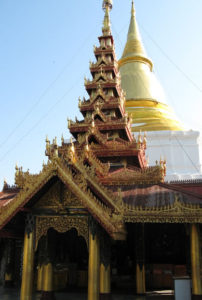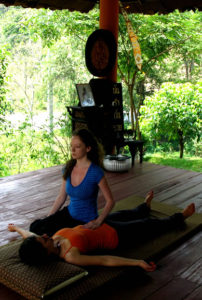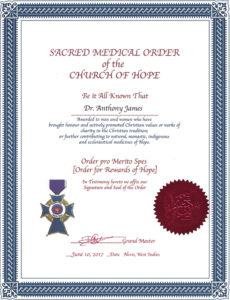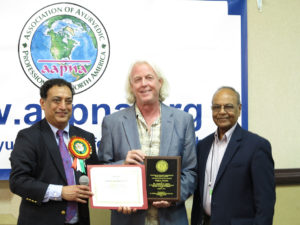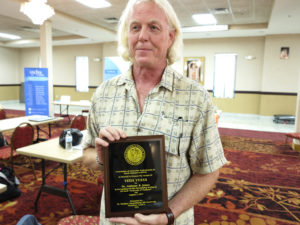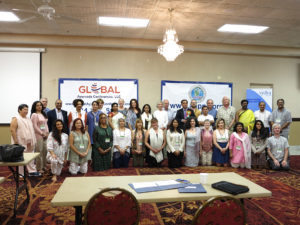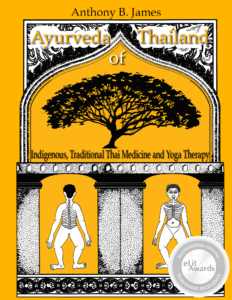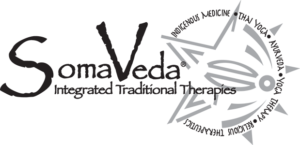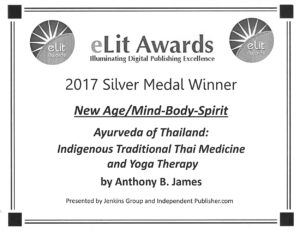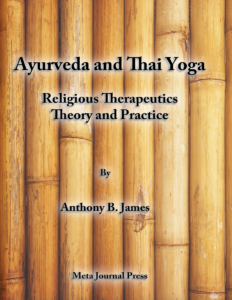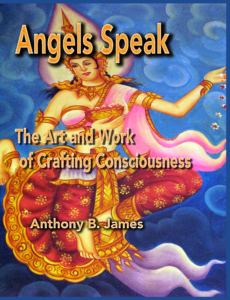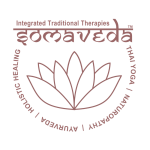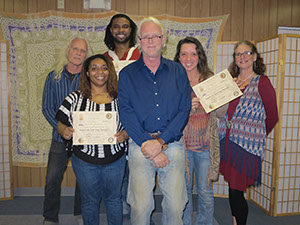Ayurveda Perspective on Hypothyroidism
by Scott Gerson, M.D., Ph.D. (Ayu), Medical Director, The Gerson Institute of Ayurvedic Medicine
The thyroid gland is an endocrine gland located in the neck below the thyroid cartilage (which forms the laryngeal prominence, or “Adam’s apple”). The isthmus (the bridge between the two lobes of the thyroid) is located inferior to the cricoid cartilage.
The thyroid gland controls how efficiently the body produces and utilizes energy, and affects almost every tissue and organ in the body. The only exceptions are the brain, ovaries, testes, spleen, and the thyroid gland itself. It acts by producing thyroid hormones, the principal ones being triiodothyronine (T3) and thyroxine (T4). T3 and T4 are synthesized from both iodine and tyrosine. The thyroid also produces calcitonin, which plays a role in calcium homeostasis.
Hypothyroidism is a condition in which the thyroid gland does not produce a sufficient amount of the thyroid hormones thyroxine (T4) and triiodothyronine (T3). It is estimated to affect between 3.8-4.6% of the general population. Approximately 0.3% of the general American population have overt hypothyroidism, and 4.3% have subclinical hypothyroidism. Globally, iodine deficiency is the most common cause of hypothyroidism. In areas where dietary iodine is sufficient, hypothyroidism is most commonly caused by Hashimoto’s thyroiditis. It can also (rarely) be caused by post-partum thyroid inflammation, certain medications, congenital abnormalities (failure of the thyroid gland to develop), or stress.
Stress and Hypothyroidism
In fact, stress is known to be a significant contributor to thyroid dysfunction. Whenever you experience stress, your adrenal glands produce cortisol. This is an evolutionary protective mechanism that originally developed as a response to physical threats. It creates the “fight or flight” response and once the physical threat is gone, cortisol levels go back to their normal levels. Its primary functions are to:
- increase blood sugar through gluconeogenesis in the liver • increase blood sugar through the breakdown of glycogen to glucose • raise the blood pressure • suppress inflammation • suppress the immune system
Elevated cortisol is intended for short term stressful events. However unfortunately, your body does not know the difference between an sudden attack by a dinosaur and raising twin two-year olds. It is the duration and accumulation of stress and not the type of stress that causes high levels of cortisol.
Every cell in the body has receptors for both thyroid hormone and cortisol. Cortisol acts synergistically with thyroid hormone at the epigenetic level. Normal levels of cortisol (neither too much nor too little) need to be present bound to its receptors for optimal function of not only the thyroid gland itself but for every tissue in the body. Too much cortisol causes the tissues to no longer respond to the thyroid hormone signal. This is known as thyroid resistance, meaning that thyroid hormone levels can be normal, but tissues fail to respond as efficiently to the thyroid signal. It can cause TSH levels to be elevated while T4 and T3 are within the normal range.
Excess cortisol has an adverse direct affect on thyroid function. It inhibits deiodinase (the enzyme responsible for the conversion of T4 into T3 in the body tissues) and also leads to an increased risk of Hashimotos thyroiditis (thyroid autoimmune disease). The latter effect is the result of cortisol causing an abnormal the ratio of T1 and T2 lymphocytes. A shift toward T1 may be associated with Hashimotos.
Symptoms
The symptoms of hypothyroidism are quite variable, depending on the severity of the hormone deficiency and of course one’s constitutional make-up. But in most cases, symptoms tend to develop slowly, often over a number of years. They typically include any or all of the following:
Chronic fatigue, weight gain, depression, low blood pressure, sensitivity to heat and cold, paresthesias, bradycardia, elevated LDL- cholesterol, reactive hypoglycemia, hoarseness, constipation, headache, muscle weakness, joint stiffness, swollen face, menorrhagia (heavy and prolonged menstruation), cramps, memory loss, visual problems, infertility and hair loss.
Ayurvedic Perspective on Hypothyroidism
Galaganda
There is no direct mention of the thyroid gland in Ayurveda. But a disease by the name galaganda is mentioned in various samhitas. The earliest description of neck swelling is found in the atharvaveda by the name apachi (a non-suppurative swelling in the neck, axilla, or groin). Charaka first described the disease as one of the 20 varieties of sleshma (kaphaja) vikaras (disease). Sushruta explicitly wrote that out of seven layers of the skin, the sixth layer, Rohini, is galaganda rogadhistana-(Su.Sa.IV/4). In the nidana sthana he describes galaganda as two encapsulated small or big swellings in the anterior angle of the neck, which hang like a scrotum (Su.Ni.XI), whereas Charaka describes galaganda as solitary swelling (Ch.Ch.XI).
The etiological factors in galaganda include climatic conditions, water supply, dietary conditions and other surroundings. Sushruta stated that rivers flowing towards east might give rise to the occurrence of galaganda. Bhela states that galaganda is more common in prachya desa (eastern part) of the country. Harita samhitakara described the role of dustambu (contaminated water) in the precipitation of galaganda. Kashyapa samhita says that any part of the country which is cold, damp, with densely grown long trees, water stagnation and heavy rains may promote the development of galaganda.
From the above descriptions it is tempting to associate galaganda can be with goiter (abnormal swelling of the thyroid gland) or some type of neck tumor, where thyroid functions may or may not be compromised. But hypothyroidism is not just a localized disease. It has many symptoms related to many systems of the body. None of these manifestations are mentioned in the ancient texts. Thus it is probably inaccurate to draw a parallel between hypothyroidism and galaganda.
Ayurvedic Treatment
According to modern Ayurvedic therapeutic science, a decrease or increase in the normal working of thyroid gland results in the ailments of hypothyroidism or hyperthyroidism, respectively. Like all nija rogas (internally caused diseases), the root cause of hypothyroidism is a disequilibrium of the doshas. There is in general vitiation in the Kapha dosha and Pitta dosha (water and fire body humors). Ayurveda teaches that thyroid disease is affected by diet and lifestyle discrepancies which further promote the doshic imbalance.
Diseases are classified in Ayurveda as either Sukhasadhya, Kruchrasadhya, Yapya or Asadhya. Sukhasadhya diseases, can be easily cured. Kruchrasadhya diseases are difficult to cure. Yapya diseases recur when the treatment is stopped and Asadhya signifies those diseases that are incurable. Ayurveda considers most forms of hypothyroidism a yapya disease.
Thyroid Therapy
Ayurveda therapy for thyroid disease is a holistic and supportive therapy that aims to correct the doshic imbalance and hence the flawed function of the thyroid gland. Therapy includes the recommendation of herbal medicines principally for dosha balance and to some extent specifically to promote thyroid function, dietary guidance, and lifestyle recommendations.
Thyroid Medicines
No dosages or methods of preparation are given to emphasize the absolute requirement for an Ayurvedic physician to prescribe these medicines.
Single medicines include: Kanchanara leaves, Guggulu oleoresin, Ashwagandha root, Brahmi leaves, Punarnava leaves.
Compound medicines include Kanchanar Guggulu, Punarnava mandoor*, Ashwagandharishta, Amritadhaya taila and Mahayogaraj guggulu**.
All medicines for hypothyroidism need to be taken under the supervision of an experienced Ayurvedic physician (Vaidya). Also, as these thyroid medicines help in regulating metabolism as well as detoxifying the body, you may need to increase your water intake and include a bland diet along with taking medicines meant for thyroid balancing.
* contains ferric oxide (iron) and is used only if there is accompanying anemia. **contains mercuric sulfide, tin oxide, ferric oxide, ferrous silicate, and silver oxide.
Hypothyroid Diet and Lifestyle Guidance
- Assuming there is no food intolerance or lactase deficiency one can consume milk and milk products. Also rice, barley, green grams, Bengalgram (chaana dal), sugarcane juice, cucumber and fruits and vegetables which are pittakapha ahara (reduce both pitta and kapha, (see diets on our website)
- Restrict the salty and sour tastes in your diet.
- Ayurveda acknowledges the benefit of specific Yoga asanas and pranayama (breathing techniques) in the management of hypothyroidism. These asanas include:
Yogamudrasana Yoganidrasana Halasana Sarvangasana Suryanamaskar Suptavajrasana Matasyasasna
- Pranayama techniques of Jalandhar bhanda and Ujjayi Pranayaam
Iodine is a controversial subject for hypothyroid patients. One of the most classic signs of iodine deficiency is an enlarged thyroid gland and goiter: conversely, people with Hashimoto’s disease often develop goiter that can be aggravated by supplementing with additional iodine, especially in large doses.
Iodine is found in shellfish, seaweed, deep-water fish and certain vegetables, including: garlic, chard, spinach, and mustard and turnip greens, lima beans, sesame seeds, and soybeans. The iodine content in food does not seem to aggravate a Hashimoto’s thyroid in the same way as it does when administered in supplements, but it is still prudent not to consume these items in large quantities.
Selenium deficiency is also a preventable environmental factor in Hashimoto’s disease. The recommended daily allowance of selenium is normally 55 mcg (micrograms), but for Hashimoto’s patients it is reasonable to increase this to 200 mcg daily either through the diet or supplementation. Selenium foods (mcg/per serving) include: brazil nuts (540!), most salt-water fish (50-90), shellfish (50-60), mushrooms (15-20), meats (20-30), poultry (30), eggs (10), and whole grains (20-25).
As we all are constitutionally, metabolically, and genetically different, with we will respond to standard Ayurvedic treatments in idiosyncratic ways. Therefore the therapeutic approach to any disease or condition is always individually formulated.
Reprinted with authors permission.
Read original Article Here!
